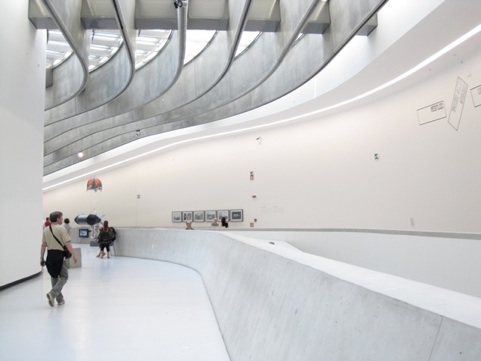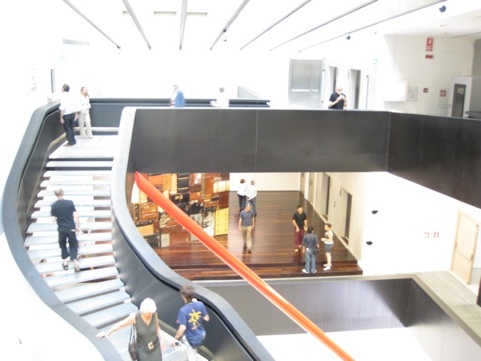
Italy comes to terms with contemporary art MAXXI opens in Rome

After decades of neglecting contemporary art, Italy opens its first national museum dedicated to it. Pieternel Vermoortel describes the new venue designed by Zaha Hadid.
Twelve years after the initial design by Hadid found approval, MAXXI, the museum for contemporary art and architecture in Rome opened its doors on May 30th. The reason for this delay might be found in the ongoing political struggle in Italy; in the inconsequent support structure in place for contemporary art or it might be due to the actual design. Besides all these speculative reasoning it is a fact that last week Italy’s first national museum dedicated to contemporary art and architecture has been inaugurated.

When walking trough the doors it becomes obvious that – as anticipated – the architecture takes centre stage, challenging and also overwhelming the artworks with it’s sloping floors and flowing galleries. The exhibition space resolves into entrance space and corridors hosting the bookshop and coffee stand, floors glide into walls and constant inside – outside relations mark the architectural design. A contained exhibition space focussing within and upon its own constraints is almost impossible, as it offers nothing resembling a ‘white cube’. This except from two smaller rooms on the ground floor which host the exhibition by the late artist Gino de Domenicis, The Immortal, curated by Achille Bonito Oliva and Kutluğ Atamans’ Mesopotamian Dramaturgies, curated by Cristiana Perrella.
The main area characterised by the floating galleries is devoted to the collection embodied in the exhibition Spazio. With subdivisions in form of thematic juxtapositions such as Natural Artificial, From the Body to the City, Maps of the Real and The Scene and the Imaginary the relation between art and architecture is highlighted and reflects the overall mission of the museum. This joined presentation is not a programmatic strand whereas in the future separate art and architecture exhibitions are planned.

The exhibition though didn’t only comprise pieces from the collection but had to be extended with many loans from other Italian museums even though it hosts work by artists as Anish Kapoor, William Kentrige and Gilbert & George next to a younger generation of artists such as Lara Favaretto and Adrian Paci. The collection is only five years old and it will still take time to grow. The museum announced that it will not only build its reputation on the exhibitions programme but also through research (housing the archives of modernists architects Carlo Scarpa and Pier Luigi Nervi), its architecture, its publishing and educational department.
Though the main point of discussion in Rome between the young artists was of course the exhibition by late artist Gino de Domenicis, one might ask why a museum devoted to contemporary art takes for its inaugural exhibition a figure from its recent history. A figure that often showed disrespect for critics, curators, exhibitions and museums. One reason might be his great influence to a younger generation of Italian artists, another in his ambiguous relation to the Arte Povera. The focus on Gino de Domenicis, who lived and worked in Rome, introduces the public to an internationally lesser-known but nevertheless influential figure.

The exhibition, The Immortal, is devided in two spaces (the ground floor white cube space and the slanted gallery on the 5th floor) and gathers a large selection of De Domenicis’ research into objects and performances. Some of the work reminded me of the poetic moments Bas Jan Ader created, for example the video Tentativo di volo (1969) in which Gino de Domenicis simulates flight, leaping from a wall set atop a hill or forming squares instead of circles, a still from the 1969 video in which he threw stones into a river aiming at the transformation of the logical. Other works reveal his interest in the mystical and its relation to the physical. An example would be necrologio (1969) that announces the date and location of his own death and at the same time his immortality. On the fifth floor the exhibition continues with paintings and sculptures from the 1990s, showing his later interest in Sumerian culture and the interstellar universe.
The two rooms that show a clear distinction between the early and late work by Gino de Domenicis is also characterised in the difference in architecture. When by exception the ground floor room is quite neutral the exhibition design added an extra layer. Works that should be presented loosely in the space were placed upon little plinths, vitrines were made very elaborative and quotes by the artist were printed on the wall making me doubt on the status of the works. The fifth floor on the other hand is one big slope leading to the top of the museum. The gallery was filled with purpose built walls to host the exhibition. A design that makes me wonder to what extend it will be possible to curate every exhibition anew without trashing the budget.
- Pieternel Vermoortel
Pieternel Vermoortel


